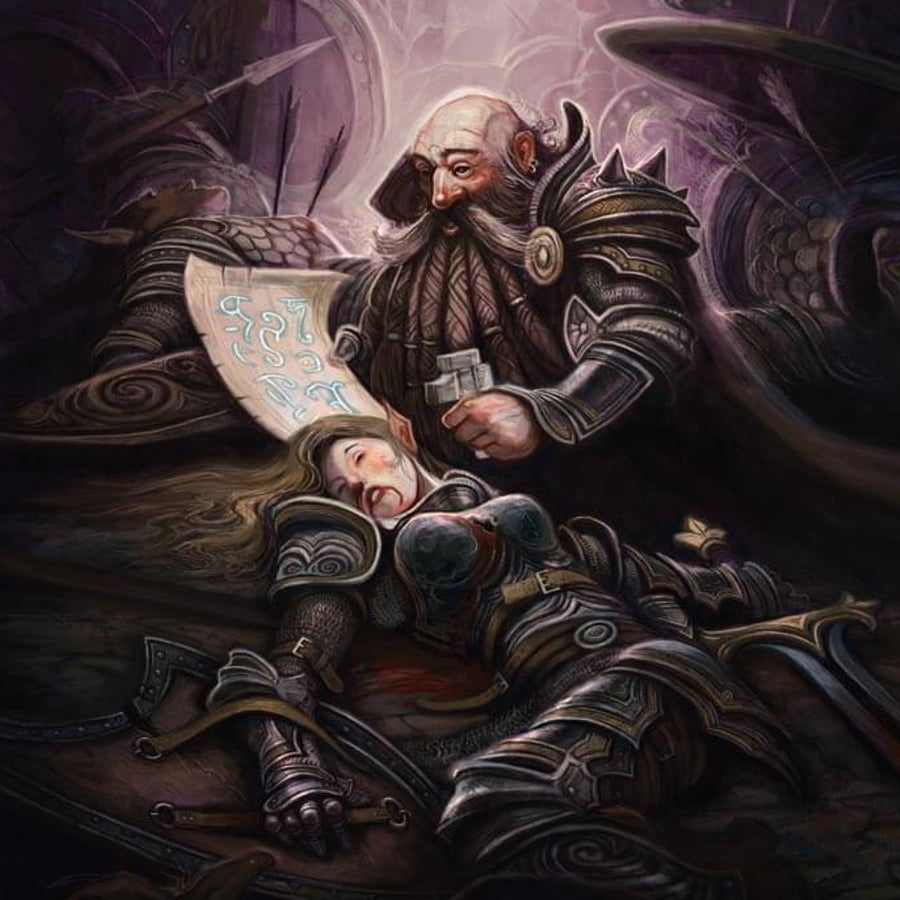6 Easy Tips to Make D&D Traps Better

Making Better Traps
By Hana the Lorekeeper and Luke Hart
Let’s be honest; traps usually aren’t the favorite TTRPG element compared to combat and roleplay. Many people would rather fight off a hoard of goblins or negotiate with a stingy merchant than attempt puzzles or traps. The reason for this is often because puzzles and traps are confusing, aren’t executed properly, or bore players. Unlike encounters, where you can throw a group of enemies on a map and have the characters solve the problem with combat or roleplay, puzzles, and traps take time and creativity to plan.
However, with a few adjustments to your traps and puzzles, players can become more engaged, challenged, and walk away from a completed puzzle or trap feeling like they can do anything. While we won’t be discussing how to build traps here (go here for Traps 101), today we’ll be going over six simple tips and tricks to spice up your traps.
By the way, running awesome games with in-depth lore, deadly traps, and terrifying monsters doesn’t have to take hours of prep! Lairs & Legends 2 and Loot & Lore 2 have everything you need! Hand-crafted by a team of professional game masters to make it as easy to use as possible, they are an anthology of game master resources to fuel you for years to come.
Watch or listen to this article by clicking the video below.
Challenge the Players, Not the Characters
Some characters are built with certain skills and situational expertise in mind. We’ve probably all been at a table where one character’s stats are designed with one specific skill or area of expertise in mind. A rogue that has Expertise in Investigation and never rolls under a 23 past 11th level when they gained Reliable Talent might be gleeful at having beaten a DC 20 Investigation check, but this isn’t engaging. You need to respect the character’s skills with Perception, Investigation, and Thieves’ Tools, but this is boring and leaves everything to be determined by a dice roll; the players aren’t being challenged.
Over the years, there’s been a debate over whether a trap should test the characters’ stats and rolls or the players’ brains and resourcefulness. Why does it have to be one or the other? The character’s skills and rolls can provide hints to the trap, but they shouldn’t override common sense, and the player should be challenged to find solutions that work with their abilities. Using tools from their inventory, searching for interactable elements in the environment, and coming up with unconventional solutions that engage the players’ brains make for a more interesting trap experience.
When your players come up with a solution to the trap problem, make sure to have them narrate how they interact with a trap element. Don’t just ask for a skill check; have the player describe their character’s actions. For example, if a trap has a ground trigger like the Flippin’ and Flingin’ trap, a monk who wants to avoid the trapped area can parkour on the hallway’s walls, or a fighter can use a rope to swing above the trigger point. The rogue doesn’t have to be responsible for every trap, and the question “how?” is your best friend. “How do you avoid the pit?” “How do you stop the fire from spreading?” By challenging the player and asking them to come up with a creative solution, not only are you engaging them, but you’re creating an image that the rest of the table can enjoy. You can even choose to grant bonuses to the checks for especially creative ideas.
Slow. It. Down.
Many traps are simple as written: the trap is triggered, everyone affected must make a save, and the results of that save are announced. There is no time to react and no time to avoid the trap’s effects once triggered. Unless the trap was detected, it’s like the Game Master sucker punching the affected characters, and honestly, it’s not a lot of fun for any player.
Instead, slow the trap down and give characters a chance to react to the trap. Complex traps already use the initiative system for elements, turning the trap into an encounter, but this principle can be applied to simple traps as well. Giving characters a chance to respond gives them the opportunity to feel useful and contribute to the group’s success.
A Clucking Prank, a simple magical trap, uses the “traps as encounters” principle. When triggered, each egg moves 30 feet per round and attempts to affect the characters repeatedly until dealt with. The party might not be within range in the first round, granting a moment for them to gather their wits. Characters who have ranged attack options such as shortbows and magic missile can snipe the eggs as they approach, while characters who don’t want to get hit can use the dodge action, granting them advantage on their Dexterity saving throw. When thinking back on this trap, your group might congratulate the ranger on their sharpshooting or the monk on their nimble dodging skills instead of remembering how they couldn’t do anything but make saves to avoid the eggs. A simple change like this can turn another set of rolls into a memorable moment.
Even if a trap triggers and acts instantaneously, using the Click Rule can help give players more control of the situation. Read more about the Click Rule and how to implement it here.
The Environment is a Tool
When the party encounters a trap, they’ll likely ask about the trap itself, trying to figure out its trigger, effects, and how to disable it. That said, traps are part of the environment, and the environment should be integrated into the trap when possible, creating additional obstacles and hazards to overcome.
Instead of a simple pit that is more of an obstacle than a significant threat, add some acid at the bottom. The acid spits and steams, occasionally bursting up randomly to dissuade characters from swinging across. If they try to cross on small footstones scattered over the pit, these stones can only take so much weight before they crumble. A large underground cavern must be carefully navigated while avoiding falling stalactite, and a slicky, icy floor can impose disadvantage on characters trying to avoid a rolling boulder.
One of the most infamous traps is a room that fills up with water, toxic gas, sand, or some other hazard. While the characters are trying to figure out how to escape, it is entirely fair for creatures to come and attack the party. Swarms of quippers can attack in the water, a xorn can burrow through rising sand, and clay golems are immune to acid damage, turning an ordinary trap into a strategic puzzle of escape.
The environment is at your disposal—make it work for you!
Puzzles and Traps Together
Similar to making the trap into an encounter, combining puzzle and trap elements together can engage a player’s brain to come up with a solution. Instead of there being a single “button” to press that disables the trap, a series of buttons or lever that have to pressed or pulled in a specific order can be used to disable the trap.
For example, there is a room that is filling up with toxic gas, and the characters must constantly make Constitution saving throws against its effects. The door to escape is locked with a set of buttons that picture a house, dog, flower, sword, frying pan, and church. Two of the buttons must be pressed to open the door, and if nothing is done, the party will be knocked out or killed when the gas completely fills the room. It’s a race against time to solve the puzzle and disable the trap against increasingly dire levels of danger.
Now, there are three ways of running this: the first is making a set solution to the puzzle, which the players have to figure out. The set solution is to press the buttons labeled with the dog and flower, since they are living and the others are not.
The second way of running this is for multiple answers to be correct. Pressing the church and house together (because they are both buildings) or the frying pan and sword together (because they are both metal objects) can be valid solutions.
The third way of running this is for the party to come up with a solution. The first two answers the party tries are incorrect, and as there looks to be no way of escape, the third answer is the one that disables the trap and unlocks the door. Use this method sparingly, as it can break the suspension of disbelief if used too frequently.
Puzzles, like traps, can be difficult for some Game Masters to construct. If you have trouble making puzzles, the internet is your friend, and there is no shame in using someone else’s puzzle if it fits with the theme of your adventure.
Seeking (or Stealing) Inspiration
Speaking of using someone else’s puzzles, we Game Masters do not live in isolated boxes, forced to rely on our own creativity. We live in the age of the internet, community projects, and libraries of previously written adventures, all these available at our fingertips. If you’re stumped on how to make a creative trap or want to up your trap game, look to previously written material for inspiration.
Adventure modules often include traps of various levels of deadliness, and using elements of these traps can enliven your own traps. Some adventures, especially older-edition D&D and Pathfinder adventures, are trap-heavy dungeon crawls. With such a variety of trap elements and effects, it’s likely that something will provide a spark of inspiration. The Hidden Shrine of Tamoachan and Tomb of Horrors modules in Tales from the Yawning Portal are both examples of trap-heavy modules. Reading through these modules, even if you don’t plan on running them, can provide ideas for some creative, if deadly, traps.
But I Can’t Design Traps...
Sometimes, you don’t have enough time to design awesome traps, and that’s okay. Game Masters are busy people, and we’re often more worried about the final boss fight than the trap that the party finds on Floor One. Work, life, friends, and family are all important, and Game Masters are expected to create awesome material for every session? Come on, are you crazy?
If you struggle to design basic traps, that’s okay, too. Every Game Master has their strong suit, and yours might not be traps. Being self-aware is a good thing and helps you cover your weak spots. You can either start improving your trap-building skills (every kobold has to start somewhere, after all), or you can use traps someone’s already built.
Places such as Tumblr, Reddit, and Giant in the Playground are littered with free ideas for traps, and 3rd Party content creators that produce content independently or on platforms such as DriveThruRPG have hundreds of resources available. There are free traps here on The DM Lair for both D&D 5th Edition and Pathfinder 2nd Edition, and searching “traps” on DriveThuRPG yields over 3,000 results! Grimtooth’s Ultimate Traps Collection has useful trap resources for struggling Game Masters of any experience level. There is no shortage of options for traps, no matter the party level or difficulty level, and why reinvent the wheel when plenty of wheels already exist?
Hopefully, these six tips can help you improve your traps and bring a new breath of life to your table! Until next time, and may the dice ever roll in your favor.
It's Time for New Legends!
Lairs & Legends 2 and Loot & Lore 2 are the ultimate game master resource. These two massive books put an anthology of everything you need to run amazing games for YEARS at your fingertips.
- Over 30 Adventures
- 30 Stand-Alone Encounters
- More than 100 Monsters
- 6 New Rule Sets
- And much more!
These books are written to make running the game easy for new and veteran GMs. Each resource is built with intuitive formatting, clear wording, and evocative art. You’ll never again have to dig through dense paragraphs to find critical details you need during a live session.
These 5e resources are designed to scale to your needs; whether it’s a quick drag-and-drop trap to add some spice to your session or complete adventures that span levels 1 to 20. The sky’s the limit with what your games can become with Lairs & Legends 2 and Loot & Lore 2.
Get Access to 1000s of Free 5e Resources!
Now, if you're on a budget, we totally understand. That's why we also offer loads of free 5e resources for folks. Just sign up for the DM Lair Newsletter to instantly get access to our entire library of free 5e resources. We'll also send you new resources every week!
-
Posted in
Game Master How-To Articles







